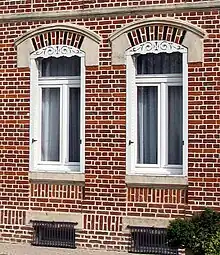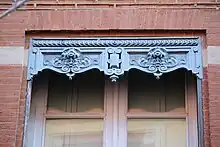_Dublin_Castle_Interior_(State_Drawing_Room).jpg.webp)


A pelmet (also called a "cornice board") is a framework placed above a window, used to conceal curtain fixtures. These can be used decoratively (to hide the curtain rod) and help insulate the window by preventing convection currents.[1] It is similar in appearance to a valance, which performs the same function but is made of fabric. A pelmet can be made of plywood, and may be painted, or fabric covered.
Exterior timber pelmets are a feature of some historic buildings, fitted on the outside of a window. These may be plain or decorative, with complex fretwork in some examples. These may be purely decorative, or serve to conceal an external blind mechanism.
Due to the appearance of a pelmet, the term is often used to describe an extremely short skirt.[2]
References
- ↑ "How Pelmets drop your heating bills dramatically". YourGreenDream. Archived from the original on March 19, 2018. Retrieved January 24, 2019.
- ↑ Arnold, Sue (20 March 1999). "There are worse things than a pelmet skirt". The Independent. Archived from the original on 2022-05-25. Retrieved 13 October 2013.
External links